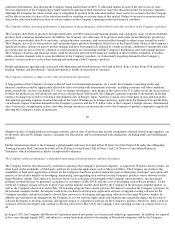Apple 2002 Annual Report Download - page 32
Download and view the complete annual report
Please find page 32 of the 2002 Apple annual report below. You can navigate through the pages in the report by either clicking on the pages listed below, or by using the keyword search tool below to find specific information within the annual report.
of the software. Defects may also occur in components and products the Company purchases from third parties that may be beyond its control.
38
There can be no assurance that the Company will be able to detect and fix all defects in the hardware and software it sells. Failure to do so
could result in lost revenues, loss of reputation, and significant expense to remedy.
The Company's retail initiative requires a substantial investment and commitment of resources and is subject to numerous risks and
uncertainties.
Since May of 2001, the Company has opened 51 retail stores in the United States and anticipates opening more stores in calendar 2003. The
Company's retail initiative has required substantial investment in equipment and leasehold improvements, information systems, inventory, and
personnel. The Company has also entered into substantial operating leases commitments for retail space with lease terms ranging from 5 to
12 years. The Company would incur substantial costs should it choose to terminate this initiative or close individual stores. Such costs could
adversely affect the Company's results of operations and financial condition. Additionally, a relatively high proportion of the Retail segment's
costs are fixed because of depreciation on store constructions costs and lease expense. As a result, should the Retail segment experience a
decline in sales for any reason, significant losses would result.
Certain of the Company's stores have been intentionally designed and built to serve as high profile venues that function as vehicles for general
corporate marketing, corporate events, and brand awareness. Because of their unique design elements, locations and size, these stores require
substantially more investment in equipment and leasehold improvements than the Company's typical retail stores. The Company has opened
two such stores and has several others under development. Because of their location and size, these high profile stores also require the
Company to enter into substantially larger operating lease commitments compared to those required for its more typical stores. Current leases
on such locations have terms ranging from 5 to 10 years with total commitments per location over the lease terms ranging from $25 million to
$50 million. Closure or poor performance of one of these high profile stores could have a particularly significant negative impact on the
Company's results of operations and financial condition.
Many of the general risks and uncertainties the Company faces could also have an adverse impact on its Retail segment. Also, many factors
unique to retail operations present risks and uncertainties, some of which are beyond the Company's control, that could adversely affect the
Retail segment's future results, cause its actual results to differ from those currently expected, and/or have an adverse effect on the Company's
consolidated results of operations. Potential risks and uncertainties unique to retail operations that could have an adverse impact on the Retail
segment include, among other things, macro-economic factors that have a negative impact on general retail activity; inability to manage costs
associated with store construction and operation; lack of consumer acceptance of the Company's retail approach; failure to attract new users to
the Macintosh platform; inability to sell third-party hardware and software products at adequate margins; failure to manage relationships with
existing retail channel partners; lack of experience in managing retail operations; costs associated with unanticipated fluctuations in the value
of Apple-branded and third-party retail inventory; and inability to obtain quality retail locations at reasonable cost.
Unit sales of the Company's professionally oriented desktop systems have declined sharply over past two to three years negatively impacting
net sales and gross margin.
Unit sales of Power Macintosh systems fell 18% during 2002 as compared to 2001 and fell 35% in 2001 from 2000. Power Macintosh unit
sales have fallen as a percentage of total Macintosh unit sales from 38% in 1999 to 25% in 2002. The Company believes that weak economic
conditions over the past several years are having a pronounced negative impact on its professional and creative customers who are the primary
users of such systems. The Company also believes that many of these customers continue to delay upgrades of their Power Macintosh systems
due to the Company's ongoing transition to Mac OS X and in anticipation of certain software vendors transitioning their professionally oriented
Macintosh software applications to run natively in Mac OS X. In addition to the negative impact on net sales, declining sales of Power
Macintosh systems also have a negative effect on the Company's overall gross margin because Power Macintosh systems are generally higher
priced and have higher individual gross margins than the
39
Company's other Macintosh systems. Continued deterioration in Power Macintosh unit sales will adversely affect the Company's future net
sales and gross margin. If future unit sales of Power Macintosh systems fail to partially or fully recover, it will be difficult for the Company to
improve its overall profitability.
The Company faces increasing competition in the U.S. education market.
Sales in the United States to both elementary and secondary schools, as well as for college and university customers, remains a core market for
Apple. Net sales in these markets fell to 21% of the Company's total net sales in 2002 from 26% in 2001. This drop reflects declines in both net
sales and Macintosh unit sales in these markets of 15% and 14%, respectively, in fiscal 2002 compared to 2001. These developments are
























